How to Plant Dragon Fruit: A Complete Cultivation Guide
- February 16, 2024
- 13 comment
Dragon fruit, also known as pitaya, is a vibrant and exotic fruit admired for its unique appearance and flavorful taste. This tropical cactus fruit, native to the Americas, is gaining popularity worldwide for its health benefits and aesthetic appeal. This guide will provide step-by-step instructions on how to plant and care for dragon fruit, ensuring a successful and bountiful harvest.
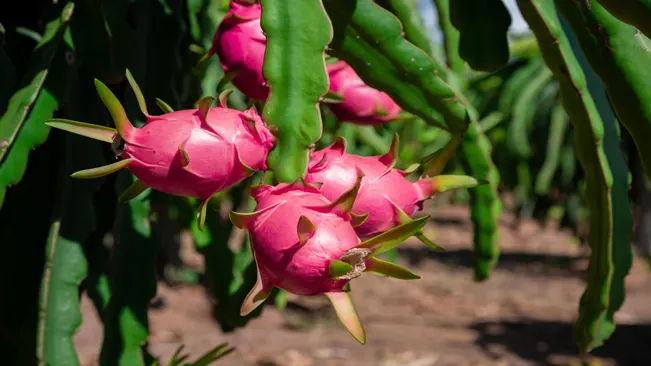
Selecting the Right Variety
Hylocereus Undatus
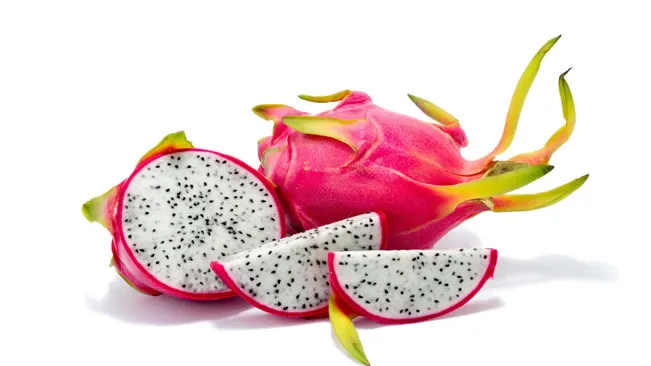
- Appearance: This variety is perhaps the most recognizable, featuring a striking pink or red skin with prominent green scales. The flesh inside is usually white, peppered with tiny black seeds.
- Taste and Texture: The white flesh of Hylocereus undatus is mildly sweet and has a texture often compared to kiwifruit. It’s refreshing, with a balance of sweet and tart flavors.
- Growing Conditions: It adapts well to a range of climates but prefers tropical or subtropical environments. It’s relatively tolerant of colder temperatures compared to other varieties, but still cannot withstand frost.
- Popularity: Due to its widespread cultivation and pleasant taste, it’s the most commonly available variety in markets and stores.
Hylocereus Costaricensis
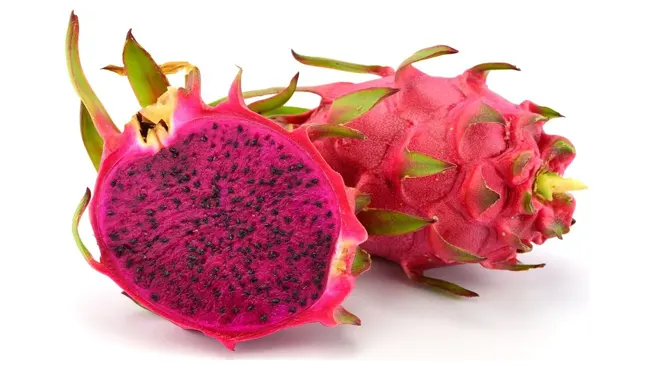
- Appearance: This variety stands out with its vibrant red or purple flesh, enclosed in a pink-skinned fruit with green scales. It’s visually striking and can be more appealing for its intense color.
- Taste and Texture: The flesh of Hylocereus costaricensis is sweeter and juicier compared to Hylocereus undatus. It has a more pronounced flavor, often described as reminiscent of a blend of berries.
- Growing Conditions: This variety prefers a hot, humid climate and is less cold-tolerant than Hylocereus undatus. It is commonly grown in Central and South America.
- Uses: Apart from fresh consumption, its vibrant flesh color makes it popular in culinary uses like smoothies, desserts, and cocktails for visual appeal.
Hylocereus Megalanthus
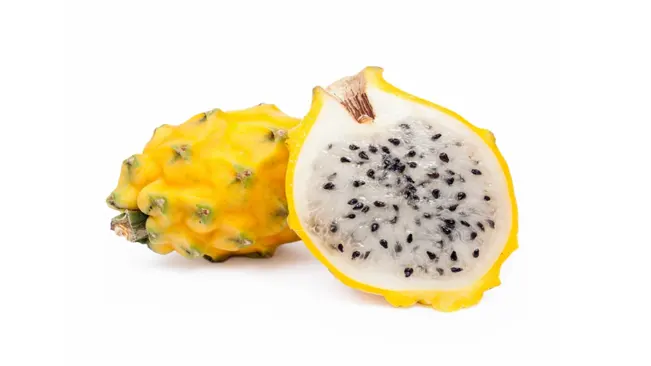
- Appearance: This variety is distinct with its yellow skin and white flesh. The skin is less spiky compared to the other varieties and the fruit is often smaller in size.
- Taste and Texture: The white flesh of Hylocereus megalanthus is sweet, with some people considering it the sweetest of all dragon fruit varieties. Its texture is similar to that of the other varieties, with a crunchy feel from the seeds.
- Growing Conditions: It requires a hot, dry climate for optimal growth. This variety is more drought-tolerant than the others but is also the most sensitive to cold temperatures.
- Unique Aspect: This variety is known for its higher sugar content and is often sought after for its sweetness.
Selecting the Right Variety for Your Climate and Taste Preferences
- Climate Suitability: Consider your local climate when choosing a variety. Hylocereus undatus is more versatile in different climates, whereas Hylocereus costaricensis and Hylocereus megalanthus prefer more specific conditions (hot and humid, and hot and dry, respectively).
- Taste Preference: If you prefer a milder, refreshing taste, go for Hylocereus undatus. For a sweeter, berry-like flavor, Hylocereus costaricensis is ideal. If you’re after the sweetest variety, choose Hylocereus megalanthus.
- Culinary Uses: Think about how you plan to use the dragon fruit. Hylocereus costaricensis is excellent for adding color to dishes, while Hylocereus undatus and megalanthus are great for a more traditional dragon fruit experience.
Choosing the Right Location
Dragon fruit plants thrive in warm, humid climates with plenty of sunlight. Select a location that receives at least 6 hours of sunlight daily. They prefer temperatures between 20-30°C (68-86°F) and are sensitive to frost.
Climate Requirements
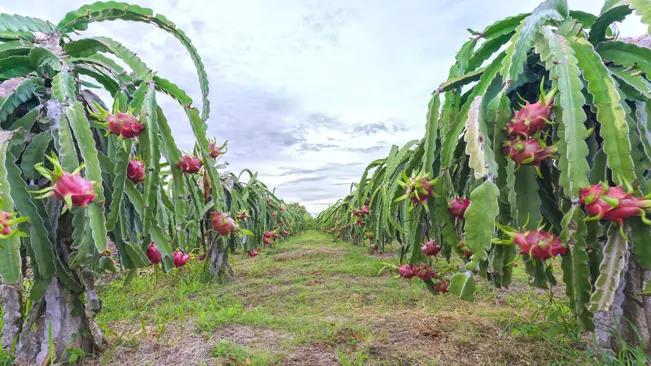
- Tropical and Subtropical Regions: Dragon fruit plants are native to tropical and subtropical regions. They thrive in environments where temperatures are consistently warm.
- Humidity: These plants prefer a relatively high humidity level. If you’re in a drier climate, you might need to take additional steps to maintain adequate moisture around the plant.
Sunlight Exposure

- Direct Sunlight: Dragon fruit plants need abundant sunlight to grow properly. A minimum of 6 hours of direct sunlight per day is ideal.
- Partial Shade: While they prefer direct sunlight, in extremely hot climates, some afternoon shade can be beneficial to prevent sunburn on the fruit and leaves.
- Orientation: South-facing locations often provide the most consistent sunlight in the Northern Hemisphere, with the reverse being true in the Southern Hemisphere.
Temperature Range
- Ideal Temperatures: Dragon fruit plants grow best in temperatures between 20-30°C (68-86°F). They can tolerate minor fluctuations outside this range but are sensitive to extreme temperature changes.
- Frost Sensitivity: These plants are not frost-tolerant. Temperatures below 0°C (32°F) can damage or kill the plant. In areas with colder climates, dragon fruit can be grown in containers and moved indoors during colder months.
Protection from Wind
- Wind Shielding: Strong winds can damage the plant and its support structure. Planting in a location shielded from strong winds or providing a windbreak can be beneficial.
Microclimate Considerations
- Assessing Your Garden’s Microclimate: Every garden has microclimates. Observe your garden to identify spots that receive ample sunlight, have good air circulation, and are protected from harsh winds.
Soil Drainage
- Elevation and Slope: Elevated or sloping areas in your garden can ensure better drainage and prevent waterlogging, which is crucial for the health of dragon fruit plants.
Soil Preparation
Dragon fruit plants require well-draining soil to prevent root rot. A mix of sand, compost, and regular garden soil in equal parts is ideal. Ensure the soil pH is between 6 and 7 for optimal growth.
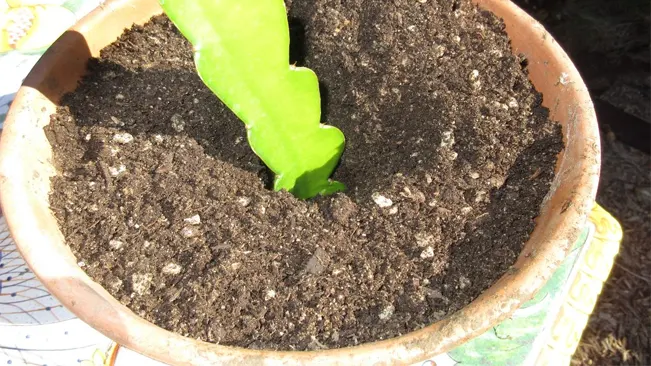
Components of the Ideal Soil Mix
- Sand: Sand is crucial in the soil mix as it facilitates drainage. Coarse sand or horticultural sand is preferred as it doesn’t compact over time, allowing water to flow freely.
- Compost: Compost adds essential organic matter to the soil, improving soil structure, nutrient content, and water retention capabilities. Well-rotted compost is best as it’s less likely to harbor diseases.
- Garden Soil: Regular garden soil provides the base for your mix. It contributes to the nutrient content and helps in retaining moisture to some extent. However, it should be loose and not prone to compaction.
Creating the Mix
- Mix equal parts of sand, compost, and garden soil. This 1:1:1 ratio ensures a balance of drainage, nutrient content, and moisture retention.
- While mixing, break up any clumps to ensure evenness in the soil texture.
Testing and Adjusting pH Levels
- Dragon fruit prefers a slightly acidic to neutral pH, ideally between 6 and 7.
- Use a pH meter or a pH testing kit to determine the soil’s pH level.
- If the pH is too low (too acidic), adding pulverized limestone can help raise it.
- If the pH is too high (too alkaline), incorporating sulfur or peat moss can help lower it.
- After making adjustments, retest the pH to ensure it’s within the desired range.
Ensuring Proper Drainage
- Conduct a drainage test by watering the soil and observing how quickly the water drains.
- If the water takes too long to drain, add more sand to improve drainage.
- Consider raised beds or planting in containers if the natural soil drainage is poor.
Planting
Planting from Seeds
This method involves growing the dragon fruit plant from the seeds found inside the fruit. It’s a more time-consuming process but can be rewarding.
Seed Collection
Extract seeds from a ripe dragon fruit. Rinse the seeds to remove any pulp and let them dry.

Germination
Plant the seeds in a well-draining soil mix. Covering the seeds with a thin layer of soil or vermiculite can aid in germination.

Growing Conditions
Keep the soil consistently moist and place the seed tray in a warm, bright area, but not in direct sunlight.
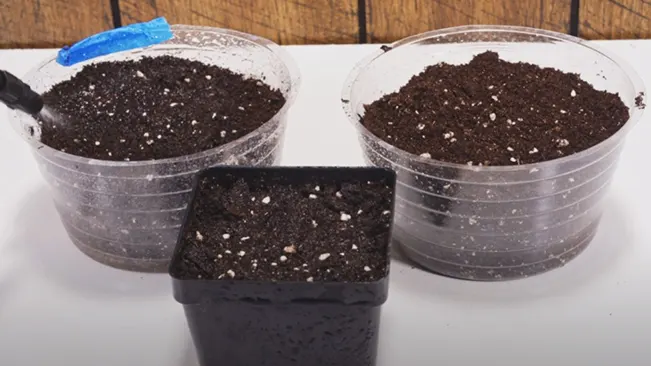
Transplanting
Once the seedlings have grown a few inches and have several sets of leaves, they can be carefully transplanted into individual pots or a prepared garden bed.
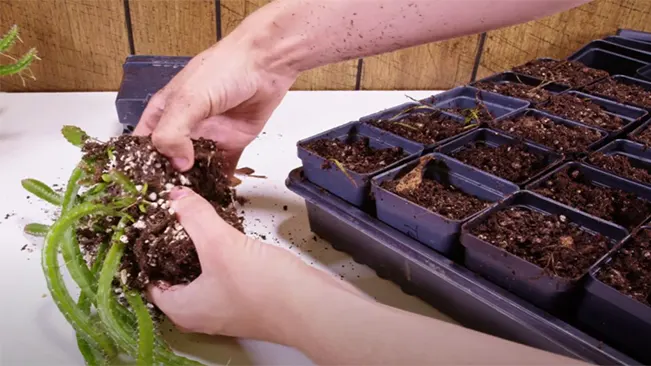
- Time to Fruit: Plants grown from seeds take longer to produce fruit, often several years.
Planting from Cuttings
This is the most common and efficient method for propagating dragon fruit. Cuttings are segments of a dragon fruit plant’s stem.
Cutting Selection
Choose a healthy, mature stem from an existing plant. The cutting should be around 15-20 cm (6-8 inches) long.
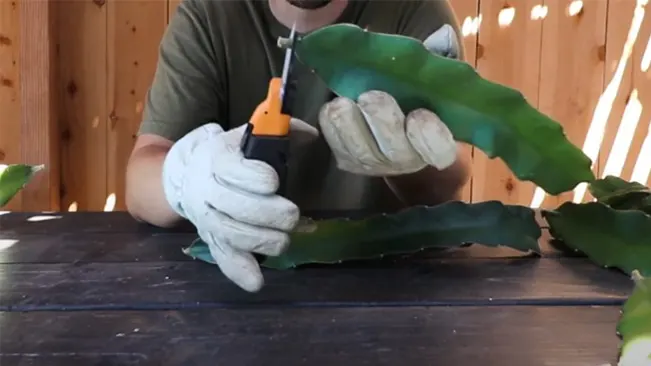
Curing
Allow the cut end of the cutting to dry and callous for several days to prevent rot and encourage rooting.
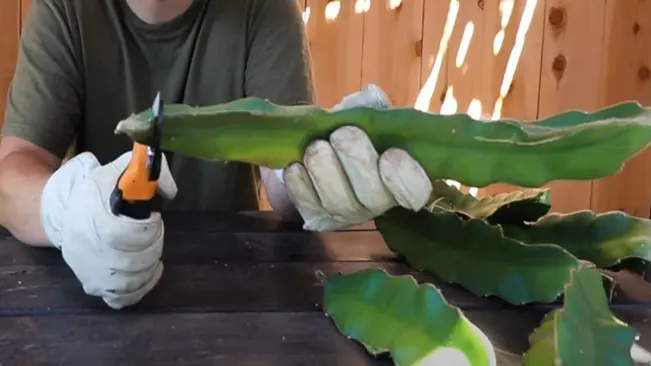
Planting
Plant the cutting in well-draining soil, burying about a third of its length.

Watering
Keep the soil moist but not waterlogged to promote root growth.
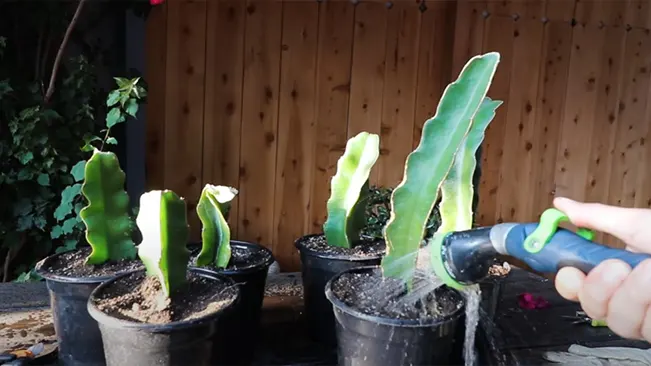
Support Structure
As the plant grows, provide a support structure like a trellis or stake, as dragon fruit plants are climbers.
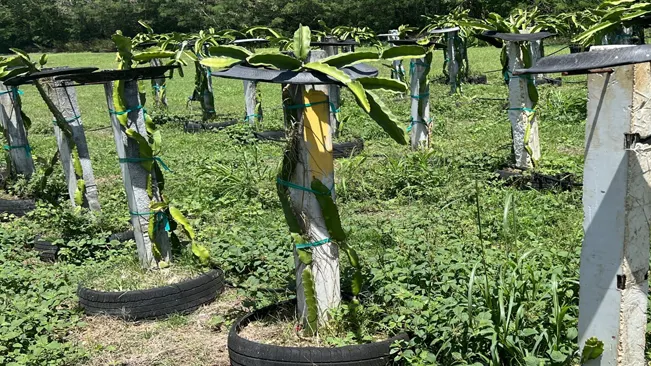
- Time to Fruit: Cuttings typically bear fruit faster than seed-grown plants, usually within 1-2 years.
Comparison:
- Time to Fruit: Cuttings bear fruit much sooner than seeds.
- Ease of Cultivation: Cuttings are generally easier and more reliable to grow as they are less susceptible to environmental variables compared to seeds.
- Genetic Consistency: Plants grown from cuttings are genetically identical to the parent plant, ensuring consistency in fruit quality. Seed-grown plants can have more genetic variability.
- Space and Care: Seedlings require less space initially but need more care in the early stages, while cuttings require more space from the beginning.
Supporting Structure
Dragon fruit plants, being a type of climbing cactus, require a support structure to grow properly and produce fruit. These structures not only support the physical weight of the plant but also play a crucial role in its overall health and fruit production.
Importance of Support
- Growth Habit: Dragon fruit plants naturally climb and spread. Without support, they would sprawl on the ground, making them susceptible to pests and diseases.
- Air Circulation: A vertical support system improves air circulation around the plant, reducing the risk of fungal diseases.
- Sunlight Exposure: Elevating the plant ensures better sunlight exposure, essential for growth and fruiting.
- Ease of Harvesting: A supported plant allows for easier access to the fruit without damaging the plant.
Types of Support Structures
There are several types of support structures that can be used for dragon fruit plants:
Trellis System
A trellis made of wood or metal provides a large area for the plant to climb. It’s ideal for larger gardens.

Single Post or Pole
A simple and common method where a single sturdy pole is used for each plant. It’s space-efficient and suitable for smaller gardens or commercial cultivation.

T-Post System
A T-shaped structure offers more support compared to a single post and allows the plant to spread more evenly.
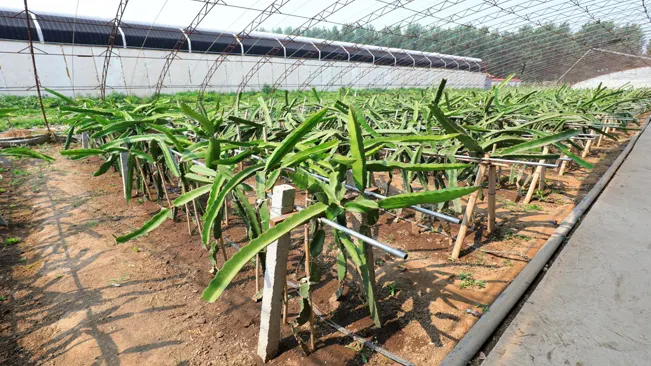
Arched or Gazebo-style Structures
These are more decorative and can be used in ornamental gardens.
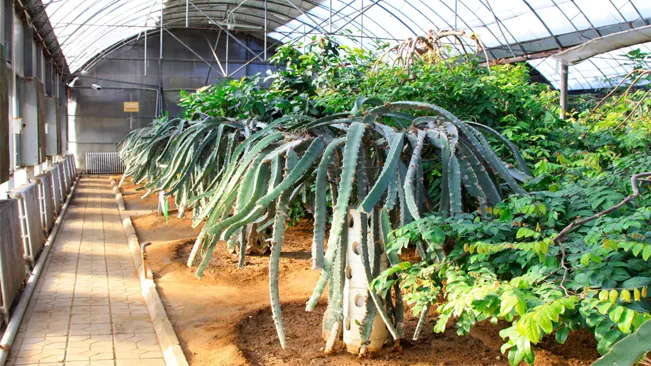
Material Considerations
- Durability: Choose materials that are durable and can withstand outdoor conditions, such as treated wood, galvanized steel, or PVC pipes.
- Height: The structure should be tall enough (typically 1.5-2 meters or 5-6 feet) to support the full growth of the plant.
- Strength: Ensure that the structure can support the weight of the plant, especially when it bears fruit.
Installation Tips
- Stability: Anchor the support structure firmly into the ground to prevent it from toppling over.
- Spacing: If using multiple supports, space them adequately to allow each plant enough room to grow.
- Training the Plant: Gently tie the young plant to the support structure with soft ties, guiding its growth upwards.
Maintenance
- Regularly check the stability of the structure, especially after extreme weather conditions.
- Prune the plant to avoid overburdening the support.
- Replace or repair any part of the structure that shows signs of wear or damage.
Watering and Fertilization
Watering Dragon Fruit Plants
Watering is a critical aspect of dragon fruit cultivation, as it greatly influences the health and productivity of the plant. Here are key points to consider:

- Frequency of Watering: The watering frequency for dragon fruit depends on the climate, season, and soil type. In general, water the plant when the top inch of the soil feels dry to the touch. This typically means watering once a week, but this can vary.
- Amount of Water: Provide enough water to moisten the soil to a depth of at least 6 inches. This encourages deep root growth, which is vital for the stability and health of the plant.
- Method of Watering: Use a drip irrigation system or water by hand to avoid wetting the foliage, as this can increase the risk of fungal diseases. Watering early in the morning is ideal as it allows excess water on the surface to evaporate during the day.
- Signs of Overwatering and Underwatering:
- Overwatering: Leaves turning yellow or dropping, and soft, mushy stems are signs of overwatering.
- Underwatering: Wilting, dry and brown leaves, and stunted growth indicate a lack of water.
Fertilization of Dragon Fruit Plants
Fertilization is essential for providing the necessary nutrients for the growth and fruit production of dragon fruit plants.
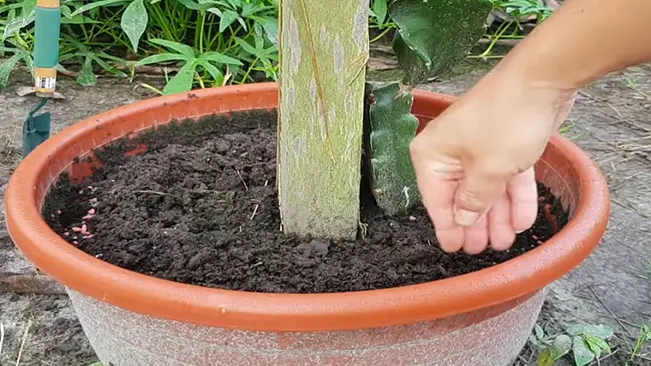
- Type of Fertilizer: Use a balanced, all-purpose fertilizer with an equal ratio of nitrogen, phosphorus, and potassium (such as a 10-10-10 NPK formula). Organic options like compost or well-rotted manure can also be beneficial.
- Frequency of Application: Apply fertilizer every month during the growing season, which typically lasts from spring to late summer.
- Reducing Fertilization in Winter: During the winter months, when the plant’s growth slows down, reduce fertilization to prevent nutrient overload, which can harm the plant.
- Application Method: Apply fertilizer to the soil around the base of the plant, avoiding direct contact with the stems or leaves. Water the soil after applying the fertilizer to help it reach the roots.
- Monitoring Plant Health: Observe your plant for signs of nutrient deficiency or excess. Slow growth, poor flowering, and weak fruit production can indicate a need for more nutrients. Conversely, overly lush foliage with little fruiting might suggest excessive nitrogen.
Pruning
Prune your dragon fruit plant to promote growth and fruit production. Remove dead or excessive growth to encourage air circulation and sunlight exposure.
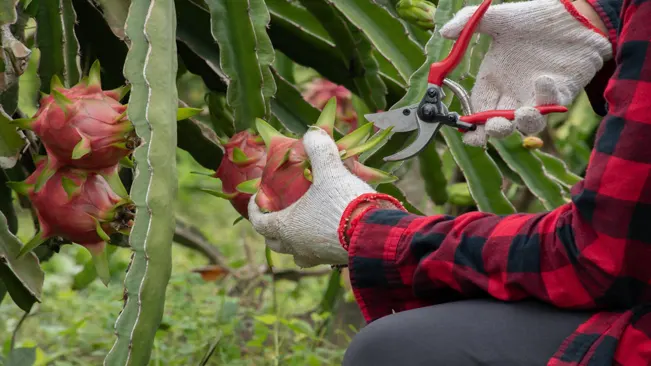
Why Pruning is Important
- Encourages Fruit Production: Regular pruning helps stimulate the growth of new, healthy branches where flowers and fruits develop.
- Improves Plant Health: Removing dead or diseased branches prevents the spread of pests and diseases.
- Enhances Sunlight Exposure and Air Circulation: Pruning helps create an open structure that allows sunlight to reach the inner parts of the plant and improves air circulation, reducing the risk of fungal diseases.
When to Prune
- The best time to prune dragon fruit plants is in the late winter or early spring, just before the new growth starts. This timing helps the plant focus its energy on producing new, fruitful branches.
How to Prune
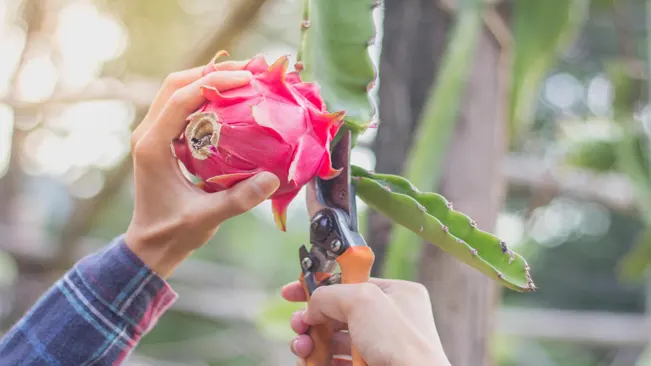
Tools: Use sharp, clean pruning shears or a saw for thicker branches. Sterilize the tools before and after use to prevent the spread of disease.
Identify What to Prune

- Remove dead, diseased, or damaged branches.
- Trim off any branches that are crossing over or growing inward towards the center of the plant.
- Cut back branches that have already produced fruit, as they are less likely to produce again.
Pruning Technique
- Make clean cuts at a 45-degree angle about 1/4 inch above a bud or branch.
- Do not remove more than one-third of the plant at a time to avoid stressing it.
Shaping
- Aim to create an open, vase-like shape that allows light and air to penetrate the plant.
- Trim the top of the plant to encourage horizontal growth if it is becoming too tall.
Pest and Disease Management
Common pests include aphids, mealybugs, and ants. Use organic pesticides or neem oil to control infestations. Prevent fungal diseases by ensuring good air circulation and avoiding overwatering.
Dealing with Common Pests
Aphids
These small, sap-sucking insects can cause significant damage by feeding on the plant’s juices, leading to distorted growth and reduced plant vigor. They also excrete a sticky substance called honeydew, which can lead to sooty mold growth.
Control Methods: A strong jet of water can dislodge aphids from the plant. For more severe infestations, use insecticidal soaps or neem oil, which are effective and environmentally friendly options.
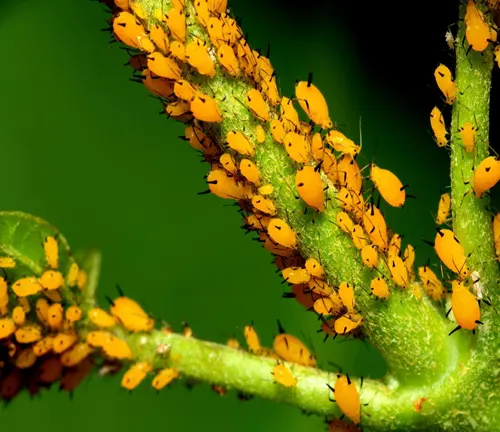
Mealybugs
These are small, white, cottony pests that suck the sap from the plant, weakening it and causing leaf yellowing and curling.
Control Methods: Physical removal of mealybugs can be done using a cotton swab dipped in rubbing alcohol. Insecticidal soaps or neem oil sprays are also effective in controlling mealybugs.
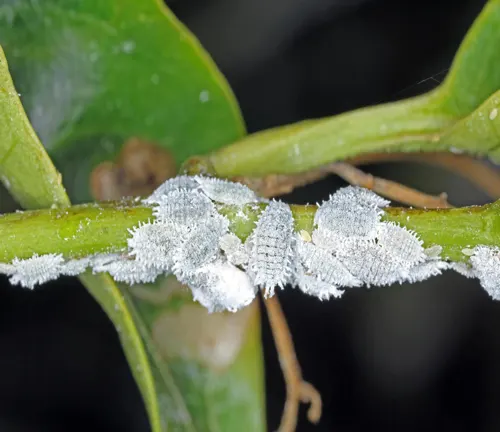
Ants
While ants themselves do not directly harm the plant, they can farm aphids and mealybugs for their honeydew, protecting these pests from natural predators and thereby exacerbating the problem.
Control Methods: Controlling aphids and mealybugs often reduces ant problems. However, ant baits and barriers can also be used to prevent ants from accessing the plant.

Preventing Fungal Diseases
Dragon fruit plants can be susceptible to fungal diseases, especially in conditions of high humidity and poor air circulation.
Root Rot
This is often caused by overwatering. Ensure well-draining soil and allow the topsoil to dry between waterings.

Stem Rot
Can occur due to high moisture and poor air circulation. Prune the plant to improve air flow, and reduce watering frequency.
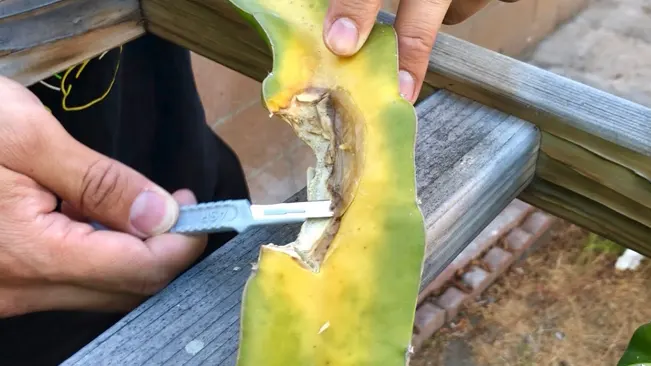
Control Methods
- Air Circulation: Prune the plant regularly to ensure adequate air flow through the branches.
- Water Management: Overwatering is a common cause of fungal diseases. Water the plant only when the top inch of the soil is dry.
- Fungicides: In cases of severe fungal infections, fungicides can be used. Copper-based fungicides are often recommended, but make sure to follow the application instructions carefully.
Organic Treatments: For those preferring organic methods, baking soda sprays (1 tablespoon of baking soda mixed with 2.5 gallons of water) can be effective against certain fungal diseases. Neem oil is also a good organic option, as it has both insecticidal and fungicidal properties.
Regular Monitoring
- Regularly inspect your dragon fruit plants for signs of pests and diseases. Early detection is key to effective management.
Harvesting
Dragon fruit is ready to harvest when its skin color changes and the wings on the fruit start to wither. The fruit should be easy to pluck from the vine.
Recognizing the Right Time to Harvest
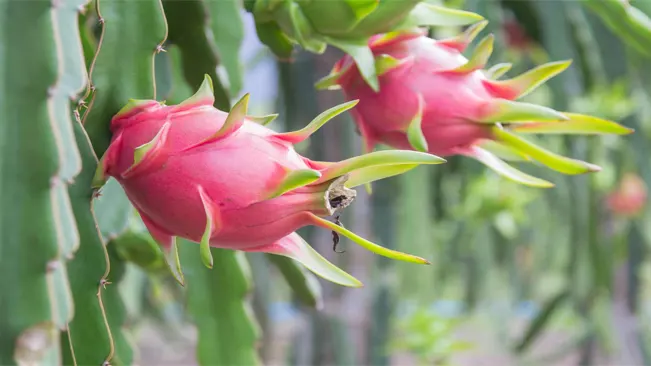
- Color Change: One of the primary indicators that a dragon fruit is ready for harvest is a change in the skin color. For red-skinned varieties, the fruit turns from a bright green to a vivid red or pink. For yellow varieties, the fruit shifts from green to a bright, sunny yellow.
- Wing Condition: The ‘wings’ or bracts on the fruit begin to wither and dry out when the fruit is ripe. These are the leafy appendages on the fruit’s body, and their change in condition is a reliable sign that the fruit is ready.
- Firmness: Gently squeeze the fruit; it should yield slightly to pressure but not be too soft. Overripe dragon fruit tends to be mushy.
The Harvesting Process
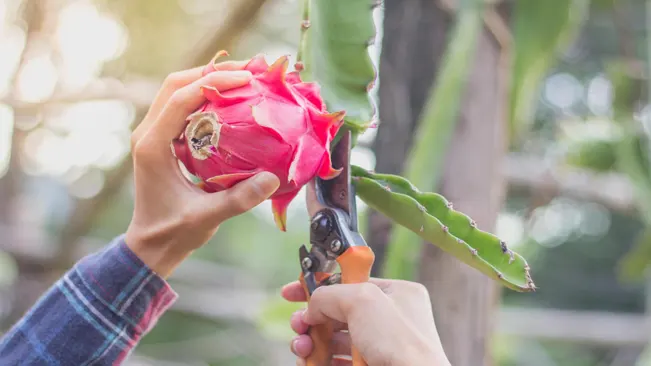
- Timing: Dragon fruit typically matures about 30-50 days after flowering. Keep a close eye on the fruit as it approaches this age range.
- Technique: To harvest, gently twist the fruit. It should come away from the vine easily if it’s ripe. If you have to pull hard, it’s likely not ready yet.
- Tools: Although not always necessary, using a sharp knife or pruning shears can help cleanly remove the fruit without damaging the vine.
Post-Harvest Handling
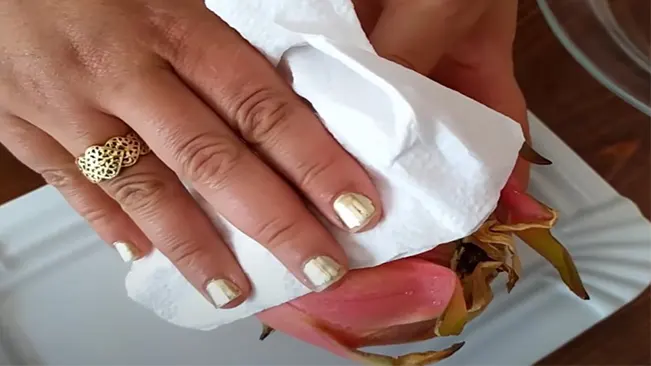
- Cleaning: Wipe the fruit with a soft cloth to remove any dirt or debris. Avoid washing it until you’re ready to eat it, as moisture can hasten spoilage.
- Storage: Dragon fruit can be stored at room temperature for a few days. For longer storage, place them in the refrigerator where they can last for up to a couple of weeks.
- Ripening: If harvested slightly underripe, you can leave the dragon fruit at room temperature to ripen. It will soften and the flavor will develop further over a few days.
Judging Quality

- Appearance: A high-quality dragon fruit should have a bright, even color with no dark spots or blemishes.
- Texture: The skin should be smooth and taut, not wrinkled or shriveled, which is a sign of overripeness or dehydration.
Conclusion
Growing dragon fruit can be a rewarding experience for any gardening enthusiast. With the right conditions and care, your dragon fruit plant will produce delicious and nutritious fruits for years to come. Remember, patience is key as it may take a few years for the first fruits to appear, but the wait is definitely worth it!
FAQs (Frequently Asked Questions)
- What is the best time of year to plant dragon fruit?
The ideal time to plant dragon fruit is in the spring or early summer when the weather is warm and there is no risk of frost. - How much sunlight does a dragon fruit plant need?
Dragon fruit plants require full sunlight for at least 6 hours a day. They thrive in bright, direct light. - What type of soil is best for dragon fruit?
Well-draining soil is crucial. A mix of sand, regular garden soil, and compost works well. The soil should be slightly acidic to neutral (pH 6 to 7). - Can I grow dragon fruit from seeds?
Yes, but it’s a slower process. Growing from cuttings is faster and more reliable for fruit production. - How do I prepare cuttings for planting?
Cut a piece of stem about 15-20 cm (6-8 inches) long. Let it dry for a few days until the cut end callouses over before planting. - How often should I water dragon fruit plants?
Water when the topsoil feels dry. Over-watering can lead to root rot, so ensure the soil is moist but not soggy. - Does dragon fruit need a support structure?
Yes, as a climbing cactus, it needs a sturdy support like a trellis or pole to grow upon. - When and how should I fertilize dragon fruit plants?
Use a balanced fertilizer once a month during the growing season. Reduce fertilization in the dormant period (typically in winter). - How do I protect my dragon fruit plant from pests?
Keep an eye out for common pests like aphids and mealybugs. Use organic pesticides or natural remedies like neem oil for control. - How long does it take for a dragon fruit plant to produce fruit?
It typically takes about 1-2 years for a plant grown from a cutting to start bearing fruit. Plants grown from seeds may take longer.

Kristine Moore
Forestry AuthorI'm Kristine Moore, a seasoned garden landscaping professional with over 30 years of experience. My extensive career has been dedicated to transforming outdoor spaces into stunning, sustainable landscapes. With a deep understanding of horticulture, design principles, and environmental stewardship, I have become a respected figure in the field, known for creating harmonious, visually appealing, and eco-friendly gardens. My commitment to excellence and continuous learning in landscaping trends and techniques has solidified my reputation as an expert in garden design and implementation.
13 comments
My desire to grow dragon fruit. 0720537452
Jackton
February 24, 2024 2:05 pmVery informative want to save to pdfs please assist
Jacinta Waringa
February 23, 2024 7:54 pmInspiring information I have been looking for! I recently acquired with little information, some seedlings of dragon fruit prepared from cuttings sent to me by my sister who does farming of same plant. Imagine I have got all the answers to the many questions I have been asking myself! Thanks to this article!
Daniel Mayogi Nyanga'u
April 14, 2024 2:06 amVery good information
MERCY GATWIRI
February 23, 2024 3:16 pmSend to me the above notes on dragon fruit and how to grow it.
David Ngereri Ngoma
February 20, 2024 11:11 amhow to treat canker what kind of fungecide to apply
ben confidentr
February 20, 2024 10:55 amIf you're dealing with canker on your plants, don't worry too much. Start by trimming away the sick parts – just make sure to go a bit beyond the visibly affected areas to catch any hidden nasties. Always clean your tools with some bleach or alcohol between cuts to avoid spreading the problem.
Kristine Moore
February 22, 2024 11:15 amVery informative
Ram Nathan
February 19, 2024 11:38 pmwhere can i get the seeds at an affordable price in kenya and is there ready market
dave
February 19, 2024 8:49 amWe needs to engage in productions of Dragon fruit can assisted me
Gebremedhin Tsegaye
February 19, 2024 7:53 amPlease email me details of where to procure, buying price per seedling, and market outlets in Kenya and yonder.
Emmanuel Atyenda Mumayi
February 18, 2024 9:13 pmI have a land and I am interested to grow dragon. Whatever do I get the seed? My farm is ready for it.









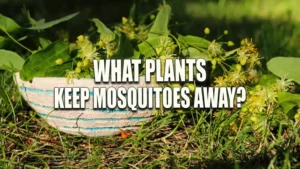



Interested in getting this article posted to me please for acurrete follow ups!
Daniel Mayogi Nyanga'u
April 14, 2024 2:11 am